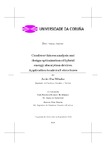Crashworthiness analysis and design optimization of hybrid energy absorption devices: application to aircraft structures

Ver/
Use este enlace para citar
http://hdl.handle.net/2183/21137
A non ser que se indique outra cousa, a licenza do ítem descríbese como Atribución-NoComercial-SinDerivadas 4.0
Coleccións
- Teses de doutoramento [2089]
Metadatos
Mostrar o rexistro completo do ítemTítulo
Crashworthiness analysis and design optimization of hybrid energy absorption devices: application to aircraft structuresAutor(es)
Director(es)
Díaz García, JacoboRomera, Luis
Data
2018Resumo
[Abstract]Amid the main research lines for the enhancement of aircraft and automotive
designs, structural optimization and crashworthiness studies are at their pinnacle.
Means of transport need to be robust and safe, albeit efficiency and lightness
cannot be neglected. While active safety systems have avoided innumerable
accidents, passive crashworthiness systems need to protect passengers when they
do occur. In the event of a crash, modern structures are designed to collapse
progressively, dissipating high amounts of kinetic energy and protecting the
passengers against abrupt decelerations. Within this broad field of study, the aim
of this thesis is that of bettering traditional crash structures by designing and
optimizing thin-walled hybrid energy absorbers, and ultimately proving reduced
occupant injury levels during representative impact scenarios.
The collapsible energy absorbers studied throughout this research originated by
combining square metallic tubes with inner cores made from glass-fiber reinforced
polymer (GFRP) and foam structures. Honeycombs are studied in depth, showing
their outstanding behavior as load bearing structures and identifying the effects
of modifying their cell’s shape. Another composite structure investigated was
that of an intertwined four-plate star core, slightly less stiff than honeycombs
but promising crushing behavior. Foam extrusions are also used as standalone
reinforcements and as filling of the inner core’s voids, always enhancing the energy
absorption capabilities of specimens. Specimens are characterized according to different crashworthiness metrics,
including their energy absorption value, peak force undergone during its collapse
and the mass of the components. Moreover, each initial design is subjected to
optimization techniques to achieve the utmost from the aforementioned metrics.
For that, finite element simulations of axial dynamic loading are parametrized as
to obtain variable core heights, material thicknesses and modifiable honeycomb’s
cell size and shape. These are later coupled with sampling and metamodeling
algorithms, constructing a surrogate model which performs accordingly with
the simulation during any fluctuation in the design variables. Later on, the
metamodels are single- and multi-objectively optimized with genetic algorithms,
yielding various sets of designs that excel in one or more of the selected responses.
As a second goals of this work, the previous energy absorber design and
the methodology used are to be applied in a significant impact scenario of a
passenger vehicle. A drop-test numerical simulation from a Boeing 737-200
fuselage section is developed and correlated with extensive experimental data,
later analyzing the crushing behavior of isolated components and their energy
absorption trends. The effect of adding hollow thin-walled tubes as vertical struts
is studied, expecting a great enhancement of the conventional design response.
Surrogate-based optimization methodologies are also applied to this simulation,
monitoring various crashworthiness biometrics and the specimen’s mass.
Results show that on a coupon basis, the usage of inner reinforcements can
modify the tube’s collapse patterns and increase its specific energy absorption
values by up to 30 %, mainly caused by the interaction between the core and
the confining structure. Moreover, reducing the core’s height has also shown
improved responses, offsetting the triggering loads of each component and yielding
peak force values 33 % lower. Topographic optimization of honeycomb cells has
revealed that the highest specific energy absorption values for dynamic loads are
not achieved with a regular cell but with a pseudo-rectangular one. The usage
of foam as cell-filling has also proved superb, increasing energy absorption by
another 28 % with minor hindering on the specimen’s mass.
As for the validation of the full size aircraft drop-test simulation, numerical and
graphical results closely match those of the experimental procedure. It was found that removing the auxiliary fuel tank from the original section increased occupant
injury levels due to high structural deformation and low energy absorption by
the main structures. In a later phase, hybrid energy absorbers are added to
the fuselage section with an empty cargo area, and a new surrogate model is
built with 600 full-scale drop test simulation. The surrogate is then single- and
multi-objectively optimized, reducing acceleration peak values by 50 % and injury
levels from severe to moderate at different occupant locations.
Palabras chave
Aviones-Diseño y construcción
Aviones-Seguridad-Dispositivos
Resistencia de materiales
Deformaciones (Mecánica)
Aviones-Seguridad-Dispositivos
Resistencia de materiales
Deformaciones (Mecánica)
Descrición
Programa Oficial de Doutoramento en Enxeñaría Civil . 5011V01
Dereitos
Atribución-NoComercial-SinDerivadas 4.0






